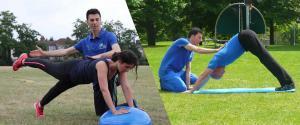Types of back injuries
Back injuries can cause excruciating levels of lower back pain and even lead to disability.
When these injuries occur, they may lead to a number of potential complications, depending on where the injury occurred and how.
Back pain is a problem faced by millions in the modern day.
In the UK alone, at least 33% of the population is affected by lower back pain, yet only 20% of these people will consult with a doctor to assist in alleviating their pain1.
Sciatica pain and a herniated disc are two common complications of back-related injuries and may also contribute to pain in the lower back.
A herniated lumbar disc is most often found among people who are between the ages of 30 to 502.
Sciatica pain is found in an estimated 1.3% to 3.1% of the UK population and as you can see in this study3, it may suggest the presence of a herniated lumbar disc.
Learn how Hayley, Jan, Dr Christian, Michaela, Elizabeth Tiffany , M Taylor and Franco successfully rehabbed their back injuries and beat their back pain.
Pain management after injury
Following a back injury, various techniques can be used to assist in the management of pain experienced by the patient.
Studies have confirmed that some forms of exercise, such as strength training, along with cardiovascular activities like walking, has beneficial effects on lumbar function and may assist in alleviating back-related pain symptoms 4.
Since incorrect posture and inappropriate activities may lead to further injury.
The utilisation of an elite personal trainer specialised in injury rehabilitation and pain management through exercise can provide a client with very effective results by training and coaching them to perform work and movement without pain.
The rehab trainer will be minimising the client’s risk of sustaining further damage to the back muscles and joints that might have been affected by their previous injury.
Points to consider before hiring a personal trainer for your back injury rehabilitation programme
There are a few points that clients should consider when they are interested in hiring a personal trainer to assist in the rehabilitation of their back injury.
Some particularly important points include:
Comfort Level
A client should feel 100% comfortable working with the personal trainer they would like to train with during their rehabilitation phase.
This is vital as it will ensure the client can adapt to the exercises more efficiently and won’t feel self-conscious when performing exercises as instructed by the rehabilitation trainer.
Education
Analysing the education of the personal trainer is also useful as this assures the client that the trainer is appropriately qualified and has gone through appropriate training to help patients recover without putting them into any further danger.
Nutrition Plan
Along with education, the client should consider if the trainer is trained and qualified to provide them with a nutrition plan as well.
Food can mediate parts of the pain level and can be just as an important factor in the rehabilitation of back injury as exercise is.
Types Of Exercises
The specific movements and variety of exercises the trainer is able to provide will have a large impact on how effective the back rehabilitation programme will be.
Home Based Exercise Programmes
Some trainers will come to the client’s house and provide them with instructions and other therapeutic services on the patient’s own premises, reducing the need for the client to visit a remote location while they are in pain.
Pain-Free Movement
Clients should ensure the exercises introduced to them by a trainer can offer improvements in their symptoms and assist in the rehabilitation of their injuries without causing further pain.
- Are suffering from back pain or an injury?
- Contact us now here for your FREE CONSULTATION.
How an elite personal trainer who is specialised in injury rehabilitation can help clients with a back injury?
An elite personal trainer specialised in injury rehabilitation is an ideal choice compared with a standard trainer who only provides a client with advice on reaching their fitness goals.
With this in mind, injury rehabilitation often results in more effective rehab approaches and a much lower risk of further injury.
An elite personal trainer will start with a comprehensive assessment of the client.
This is done through an online (emails) and a face to face interview, as well as a physical assessment, to help the trainer identify problem areas in the client and understand what needs to be done, what is safe for the client, and how they can help.
A complete back rehabilitation programme that includes both a nutrition plan and a physical activity regimen will be finely customised to the client’s unique condition.
Points to be considered by personal trainers before commencing rehab programme
When an elite personal trainer works with a client to provide them with rehabilitation services for a back injury they had suffered, there are at least three essential steps that the trainer will take in order to ensure the programme they provide the patient with is highly effective – and safe at the same time.
1. Consultation and getting diagnosed
First, a sports injury doctor needs to consult the patient and officially diagnose the conditions that are causing their back pain and sciatica symptoms.
A personal trainer will not be able to develop a customised solution that is highly effective for a specific patient if they are not sure exactly what is causing the patient’s back pain and additional symptoms that they might be experiencing.
During the examination, a physical exam might be taken of the patient, along with additional tests like x-rays, RMN etc, which will all help the personal trainer pin down the exact reasons for pain and also consider any particular damage that exists in the patient’s back region and the effect of these in the surrounding areas.
2. Designing your fully customised back pain rehabilitation plan
Once a sports injury doctor has examined the patient, and appropriate tests have been performed, the step is followed by considering the mechanisms of the injury.
Personal trainers need to take extra precautions when it comes to the rehabilitation of clients who had suffered a back injury.
Incorrect postures and inappropriate movements can lead to further damage to the client’s back, which can worsen pain symptoms and lead to additional complications – sometimes these complications may become irreversible.
The personal trainer will closely analyse the results provided by the sports injury doctor to determine what types of movements would be inappropriate for the patient and what they are capable of.
3. Timing and phasing appropriately your back recovery
Finally, the personal trainer will need to set several phases that will form part of the client’s back rehabilitation programme.
The back rehab phases will usually start out with carefully customised movements.
Slow movements will ensure the client does not overdo things during the beginning of the rehabilitation phase.
As the client progresses through the various phases, the intensity of the training programmes they will be participating in will be further customised, and gradually start to become higher in order to improve muscle strength and provide appropriate support for the joints that have been damaged through the injury that the client had suffered prior to undergoing the rehabilitation programme.
- Are suffering from back pain or an injury?
- Contact us now here for your FREE CONSULTATION.

Qualities of an efficient Personal Trainer in London that will help you in alleviating the back pain
An elite personal trainer have the qualities that will help a client to understand that they are professional, efficient, and will be an appropriate solution to assist in alleviating the back pain symptoms that the patient is experiencing.
A specialised and experienced elite personal trainer will conduct a comprehensive exercise and movement assessment on the client to help them understand that client’s existing posture, strength, flexibility, endurance and balance.
These and more will help them develop a programme that will target all of these factors, which will ultimately aid in reducing the level of pain that the patient is experiencing.
An elite personal trainer in London will also focus on factors such as improving joint stability in the client and implement appropriate strengthening exercises that contribute to stronger muscles and bones.
All muscles around damaged joints will also be strengthened through a customised solution to aid in providing these joints added support.
Additionally, clients should also assure another quality of their personal trainer lies within their ability to develop a daily activity plan that does not cause them additional pain, and a plan that focuses on providing them with safe exercises that hold no further risks.
If you find this article useful and suffer from back pain or a back injury contact us now here for your, FREE CONSULTATION.
References
1 Low Back Pain: Early Management of Persistent Non-specific Low Back Pain. NICE Clinical Guidelines. May 2009.
2 J. Jordon. Herniated lumbar disc. BMJ Clinical Evidence. 26 March 2009.
3 R. Lewis, N. Williams, H.E. Matar. The Clinical Effectiveness and Cost-Effectiveness of Management Strategies for Sciatica: Systematic Review and Economic Model. NIHR Journals Library. November 2011.
4 J.S. Lee, S.J. Kang. The effects of strength exercise and walking on lumbar function, pain level, and body composition in chronic back pain patients. Journal of Exercise Rehabilitation. 31 October 2016.




